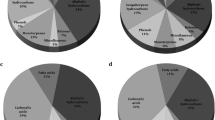Abstract
Extracts of maleMamestra brassicae (L.) hairpencils were analyzed by capillary gas chromatography (GC) and by GC-mass spectrometry (GC-MS). The extracts were found to consist of six components. Benzaldehyde, 2-methylpropanoic acid, 2-methylbutanoic acid, and phenol were present in the extracts as well as the previously identified benzyl alcohol and phenyl ethanol. The two major components were 2-phenylethanol and 2-methylbutanoic acid. They represented, respectively, 74% and 12.5% of the total blend in 3-day-old male extracts. Electroantennograms were recorded on male and female antennae in response to stimulation by hairpencil compounds. Male and female antennae responded to each chemical but the female responses were significantly higher than those of the males.
Similar content being viewed by others
References
Aplin, R.T., andBirch, M.C. 1970. Identification of odorous compounds from male Lepidoptera.Experientia 26:1193–1194.
Bestmann, H.J., Vostrowsky, O., andPlatz, H. 1977. Männchenduftstoffe von Noctuiden (Lepidoptera).Experientia 33:874–875.
Birch, M.C., Lucas, D., andWhite, P.R. 1989. The courtship behavior of the cabbage moth,Mamestra brassicae (Lepidoptera: Noctuidae), and the role of hairpencils.J. Insect. Behav. 2:227–239.
Birch, M.C., Poppy, G.M. andBacker, T.L. 1990. Scents and eversible scent structures of male moths.Annu. Rev. Entomol. 35:25–58.
Blum, M.S. 1987. Biosynthesis of arthropod exocrine compounds.Annu. Rev. Entomol. 32:381–413.
Boeckh, J. 1969. Electrical activity in olfactory receptor cells, pp. 34–51,in C. Pfaffman (ed.). Olfaction and Taste, Vol III. Rockefeller University Press, New York.
Boppré, M. 1984. Chemically mediated interactions between butterflies, pp. 261–275,in R.I. Vane-Wright and P.R. Ackery (eds.). The Biology of Butterflies. Academic Press, London.
Clearwater, J.R. 1975. Synthesis of a pheromone precursor in the male noctuid moth,Mamestra configurata.J. Insect Biochem. 5:737–746.
Fitzpatrick, S.M. andMcNeil, J.N. 1988. Male scent in Lepidopteran communication: The role of male pheromone in mating behaviour ofPseudaletia unipuncta (Haw.) (Lepidoptera: Noctuidae).Mem. Entomol. Soc. Can. 146:131–151.
Fitzpatrick, S.M., McNeil, J.N., andMiller, D. 1989. Age-specific titer and antennal perception of acetic acid, a component of malePseudaletia unipuncta (Haw.) hairpencil secretion.J. Chem. Ecol. 15:641–648.
Grant, G.G. 1970. Evidence for a male sex pheromone in the noctuid,Trichoplusia ni.Nature 227:1345–1346.
Henzell, R.F., andLowe, M.D. 1970. Sex attractant of the grass grub beetle.Science 168:1005–1006.
Jacquin, E. 1989. Etude comportementale et électrophysiologique des phéromones mâles de la noctuelle du chouMamestra brassicae (L.). Mémoire de DAA Protection des Cultures, INAPG Paris. 24 pp.
Poitout, S., andBues, R. 1974. Elevage de 28 espèces de lépidoptères Noctuidae et de 2 espèces d'Arctiidae sur milieu artificiel simplifié. Particularités selon les espèces.Ann. Zool. Ecol. Anim. 6:431–441.
Raffa, K.F., andBerryman, A.A. 1983. Physiological aspects of lodgepole pine wound responses to a fungal symbiont of the mountain pine beetle,Dendroctonus ponderosae (Coleoptera: Scolytiidae).Can. Entomol. 115:723–734.
Renou, M. 1979. Contribution à l'etude de la communication phéromonale chez trois Tinèides ravageurs des cultures:Acrolepiopsis assectella (Z.),Scobipalpa ocellatella (Boyd.),Prays oleae (Bern.), Thèse de 3ème cycle, Paris VI. 161 pp.
Stobbe, R. 1912. Die abdominalen Duftorgane der Männlichen Sphingiden und Noctuiden.Zool. Jb. 32:493–532.
Toth, M. 1982. Male produced pheromone ofMamestra brassicae L. (Lepidoptera: Noctuidae): Its possible role in courtship behaviour and study of other effects.Acta Phytopathol. Acad. Sci. Hung. 17:123–132.
Zagatti, P. 1981. Micro-comportements induits par les phéromones sexuelles chez quelques lépidoptères ravageurs des cultures en milieu sahélien. Thèse de 3ème cycle, Paris VI. 161 pp.
Author information
Authors and Affiliations
Rights and permissions
About this article
Cite this article
Jacquin, E., Nagnan, P. & Frerot, B. Identification of hairpencil secretion from maleMamestra brassicae (L.) (Lepidoptera: Noctuidae) and electroantennogram studies. Journal of Chemical Ecology 17, 239–246 (1991). https://doi.org/10.1007/BF00994436
Received:
Accepted:
Issue Date:
DOI: https://doi.org/10.1007/BF00994436




